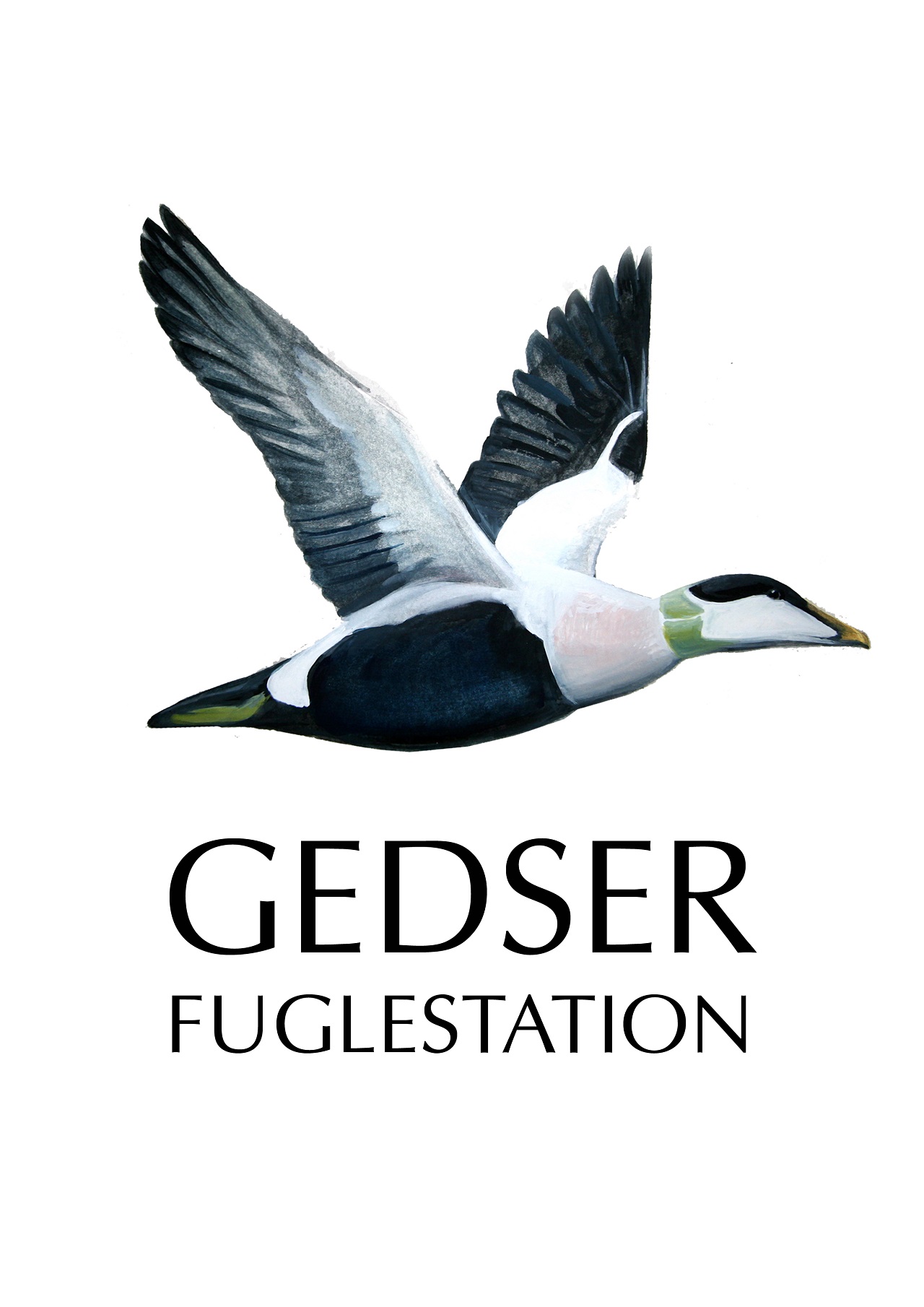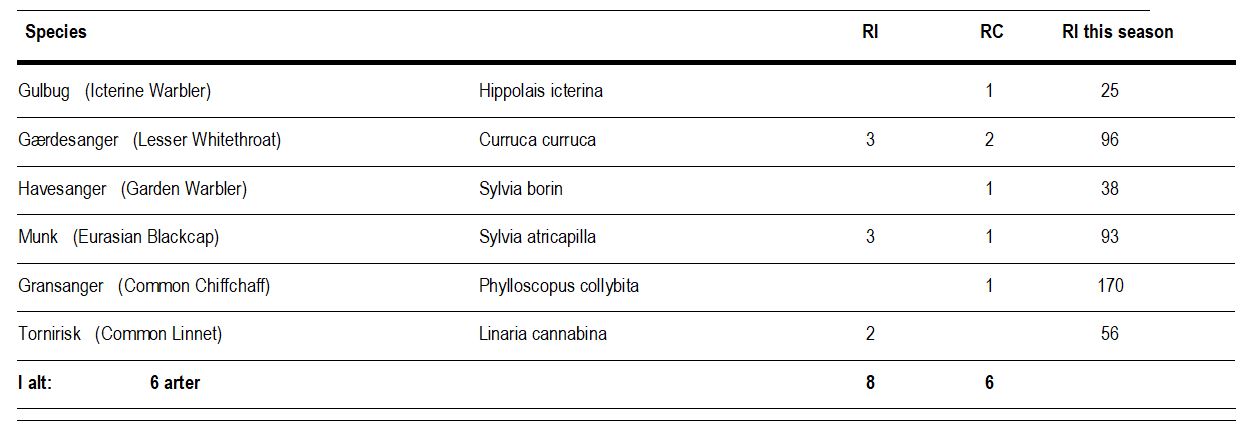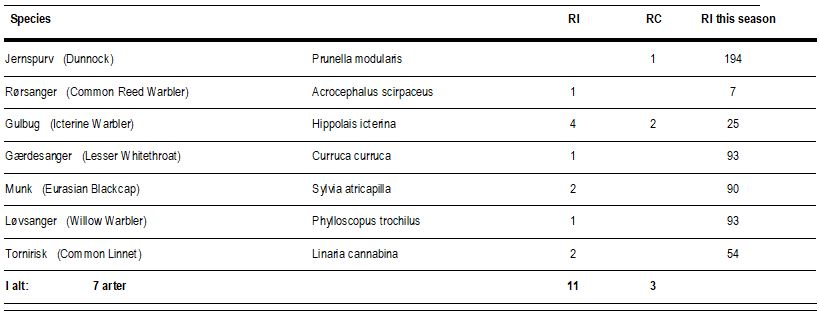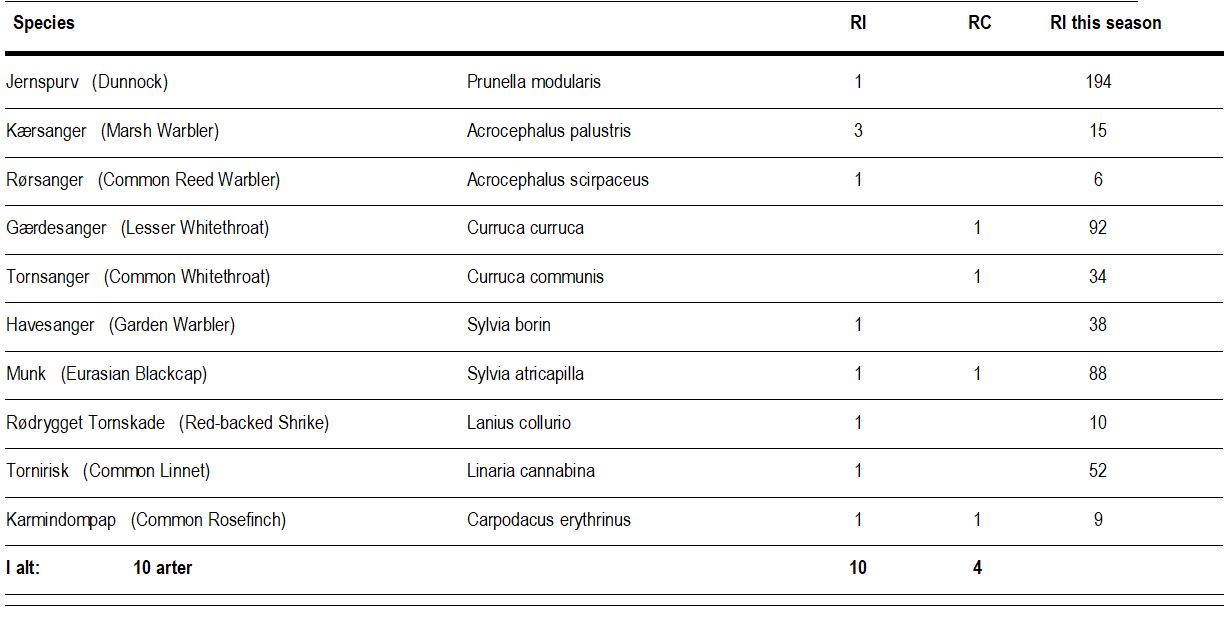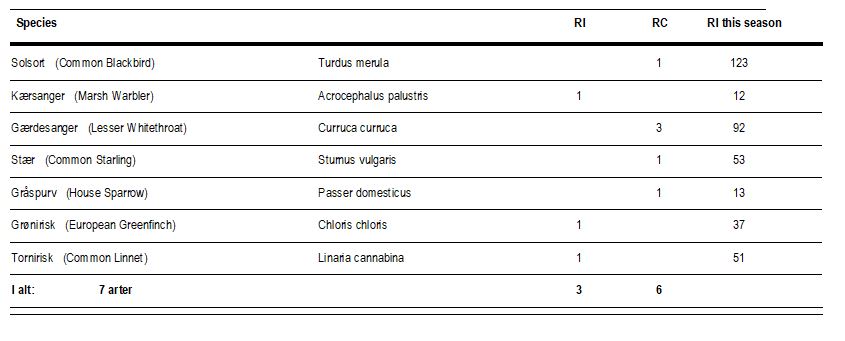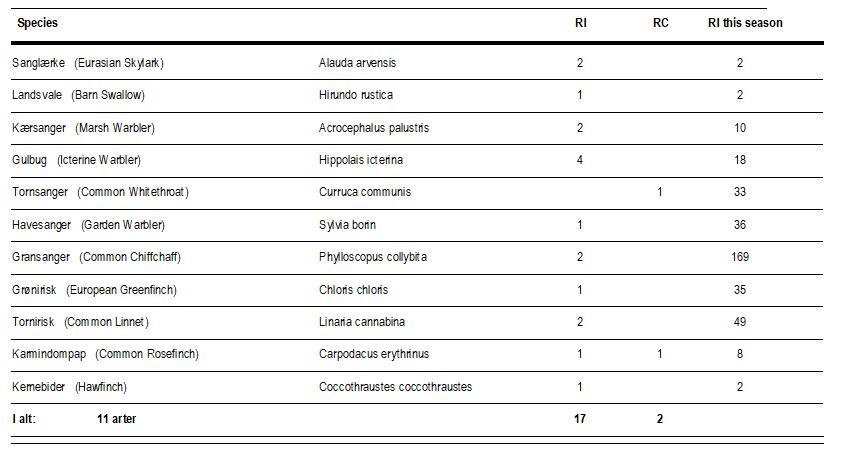Gedser Fuglestation Blog
Her på Gedser Fuglestations blog bringes korte nyheder i dagbogsformat om hændelser på fuglestationen.
Se indlæg fra måned: jan. (10)feb. (18)mar. (31)apr. (26)maj (31)juni (30)juli (23)aug. (31)sept. (30)okt. (31)nov. (30)dec. (20)
A new species for Denmark
The ringing:
The morning was a bit windy and cold again. It brought us more recaps than new ringed birds, but some nice species as Red-backed Shrike “Rødrygget Tornskade” and the first first calendar year bird of the season, that flew into the net: A Starling “Stær”.
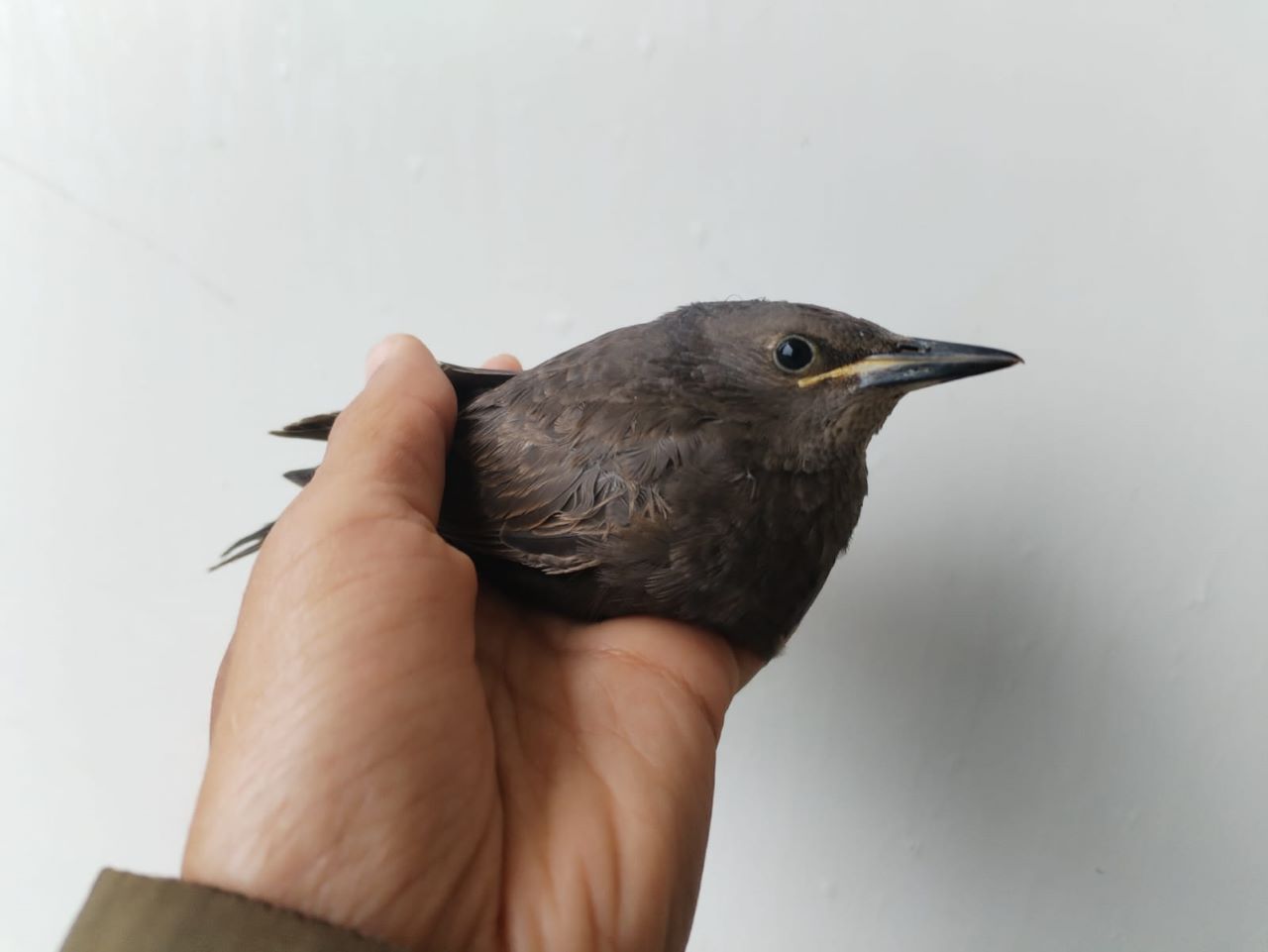
1k Starling "Stær"
A new species for Denmark:
After ringing, Gert came to the station. Soon, he got a notification on bird alarm, that a Pygmy Cormorant “Dværgskarv” was seen at Lystrup. It is a new species for Denmark and after a short time, Gert decided, we should see it. When Gert, Jens and I arrived at Lystrup, there were already many birders and I was a very cooperative bird, it was sitting on top of a dead tree all the time, very well visible for all.

Pygmy Cormorant "Dværgskarv"
The moth:
There were quite some moth species in the traps today, many I find every morning so it is usually easy to identify them. One species, that is in the traps regularly and usually very easy to identify is Oligia strigilis “Hundegræsugle”. Today I found a very dark moth of which I was wondering, if it was a new species for me, but after consulting the identification apps, books and Gert, I found out, that it was just Oligia stigilis “Hundegræsugle”. I will show a picture of how I am used to it and this dark one today, to show, how much variation there can be in some species.
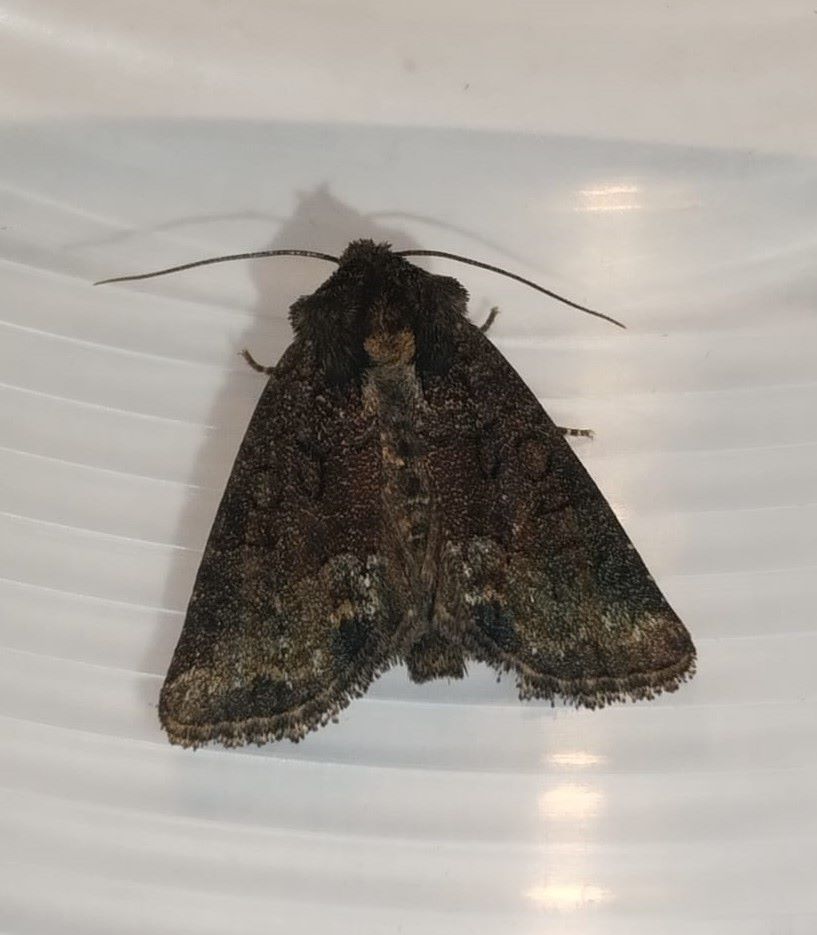
Today´s very dark Oligia strigilis.
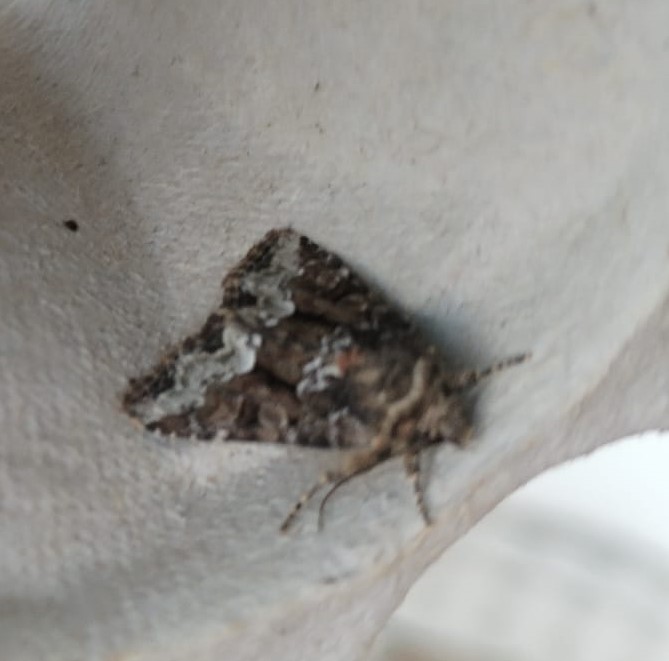
Oligia strigilis how I am used to it.
I will also put a picture of Aspilapteryx tringipennella in this blog, Robert has already used a picture of it in one of the previous blogs, but I think, it is quite nice to see it sitting on my thumb, to really see how small this micro moth is.
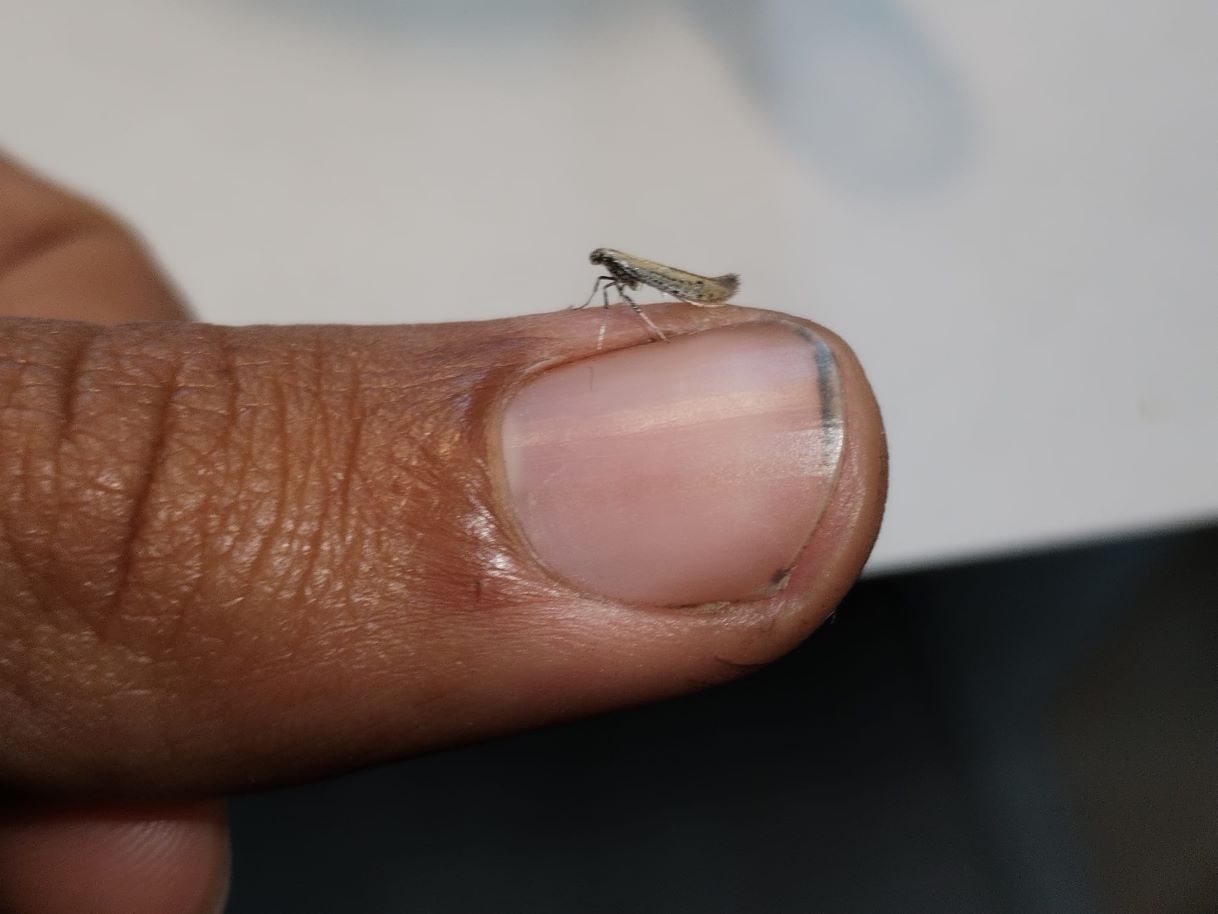
Aspilapteryx tringipennella
Even though, identification with the help of apps still works even for this size. They don´t need to stay a mystery, it is also worth looking at them!
It was quite a long day and I am very tired, so tomorrow, this blog will be updated with the list of the moth species of the day.
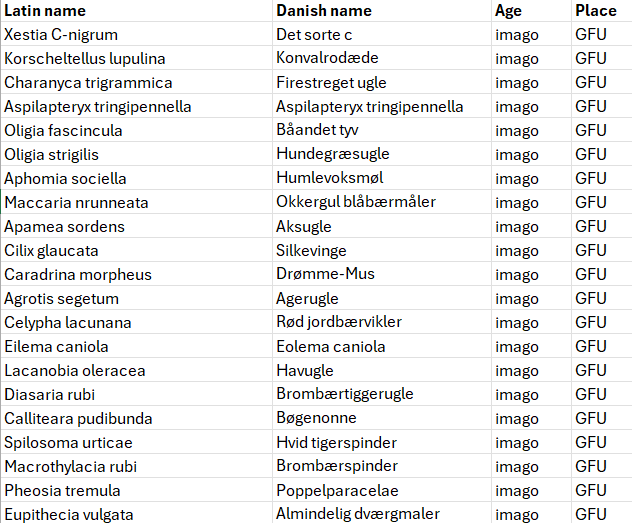
People: Jasper Mosman, Hanelie Sidhu, Jens Friis-Walsted, Gert Jeppesen
Ageing Gærdesanger
The ringing:
Although we are at the southernmost point of Denmark, it is everything else than the warmest and sunniest place here. Actually, this morning it was quite cold, but it was not as windy as yesterday and it was a bit cloudy, so we got some more birds than yesterday, 14 in total. This is not a number we are hoping for, but honestly, the season is nearly over and birds are already breeding, so we can´t really expect higher numbers than we had in May. Of course you never know and rarities can show up, so let´s be optimistic. Here a pretty picture of a recap Lesser Whitethroat “Gærdesanger”, that went in the net today. It kind of also fits to the topic of the day, as later in the afternoon, I met the volunteers from Skagen Fuglestation on zoom to give an aging session of Lesser Whitethroat “Gærdesanger”, that I had promised to prepare when I left Skagen about a month ago.
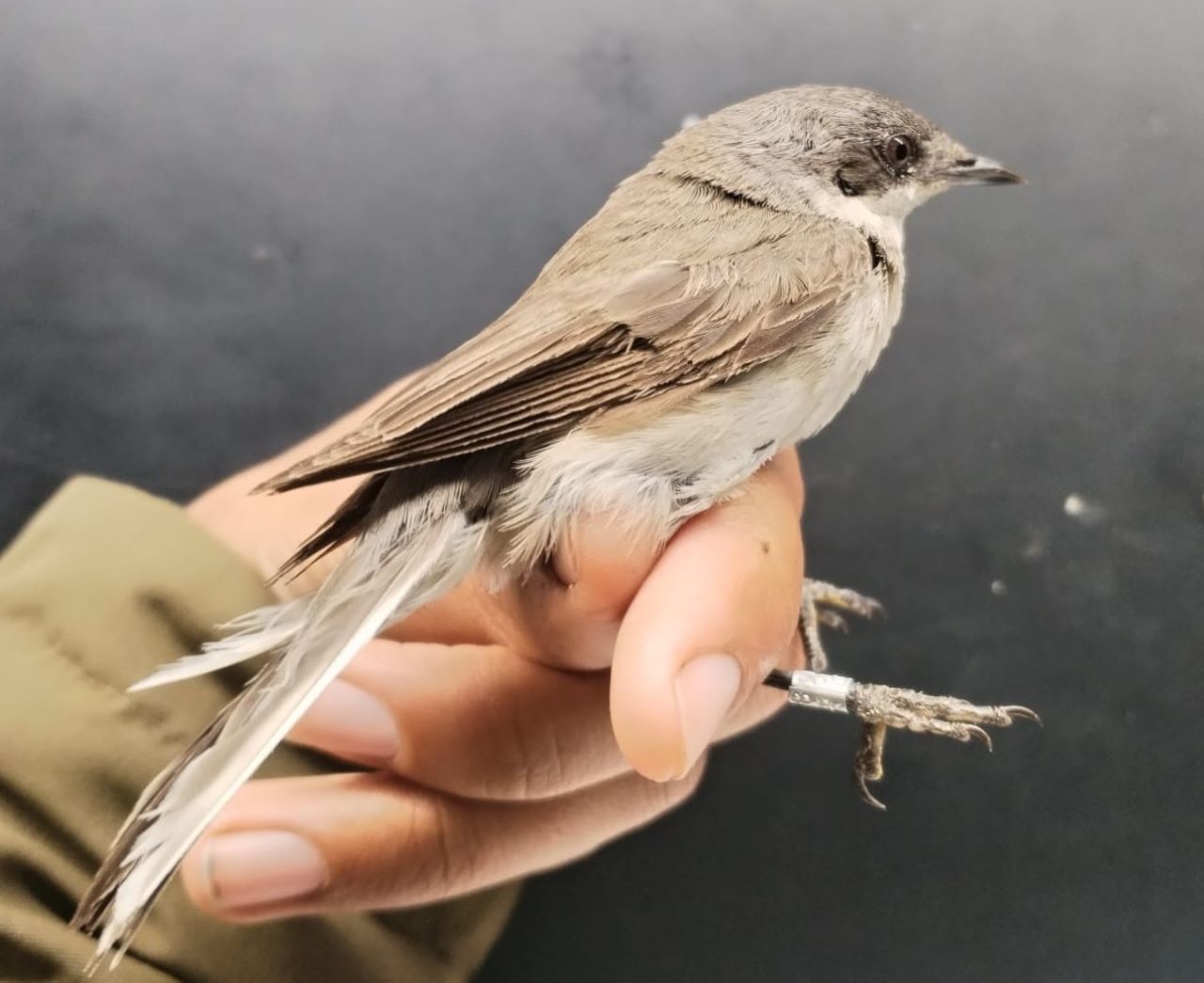
Lesser Whitethroat "Gærdesanger"
The moths:
18 moth species were in the two traps toady. My favourites were Calliteara pudibunda “Bøgenonne” and Acronicita tridens/psi “Treforkugle/Psi-ugle”.
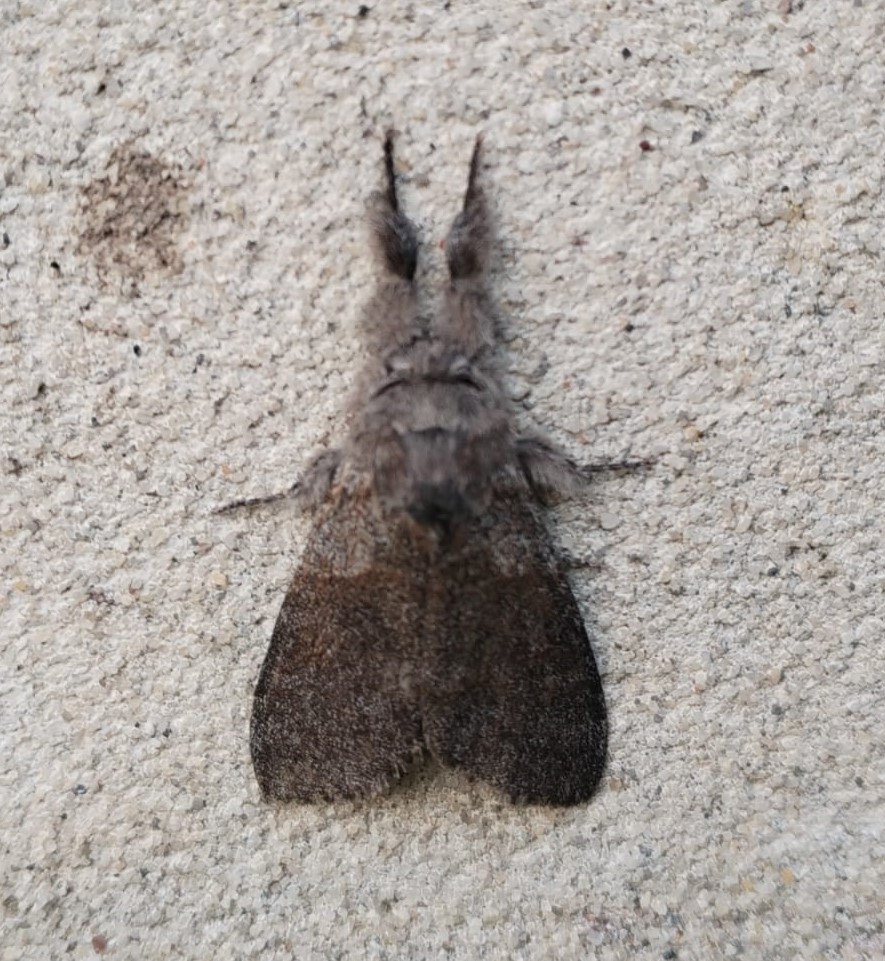
Calliteara pudibunda “Bøgenonne”
This is a male of Calliteara pudibunda, as it is greyish, while the female would be lighter and more sandy coloured.

Acronicita tridens/psi “Treforkugle/Psi-ugle”.
Acronicita tridens can not be differentiated from psi according to outer characteristics. Psi is a lot more common than tridens though, which would be quite rare here, so it is by far more likely, that it is psi that was in the trap today.
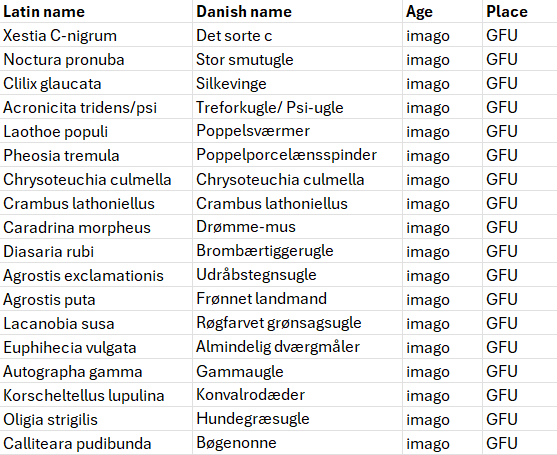
People: Jasper Mosman, Gert Jeppesen, Hans Lind, Tina Elley, Hanelie Sidhu Jens Friis-Walsted and Karsten
Wind
The ringing:
After yesterday, it looked like warm summer weather had arrived at Gedser, this morning started very cold and windy.
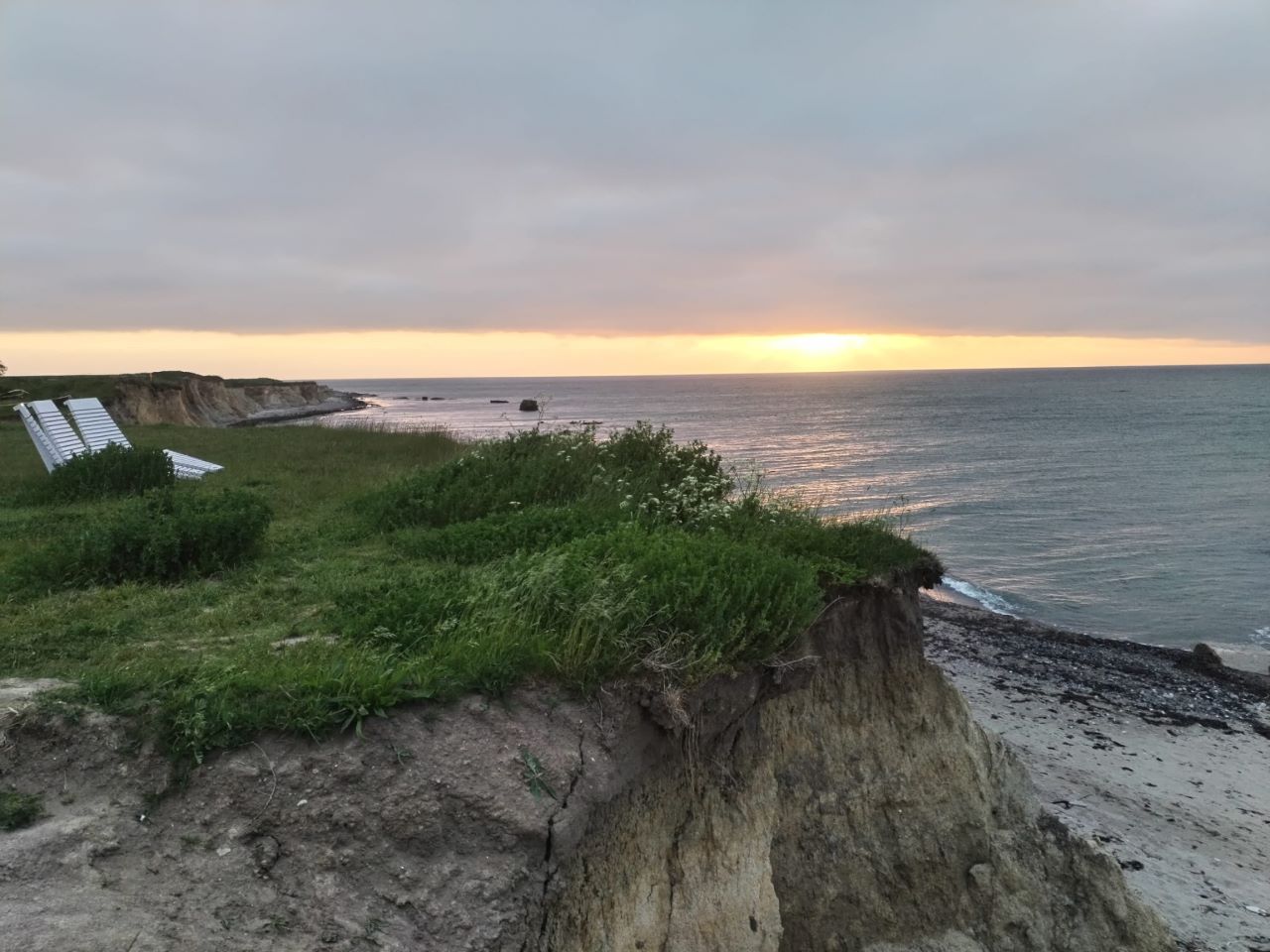
Light at the tip this early morning
Later in the morning, the wind slowed a bit down and it did not feel so cold any more. But it was not a good day for birds in the nets. That gave Jens, Karsten an me a lot of time to look for the Rose-coloured Starling “Rosenstær”, that had been seen this morning! Unfortunately, we did not have success. After two new birds in the nets and three recaptures as well as a few cut branches, we closed the nets after the five standard hours.
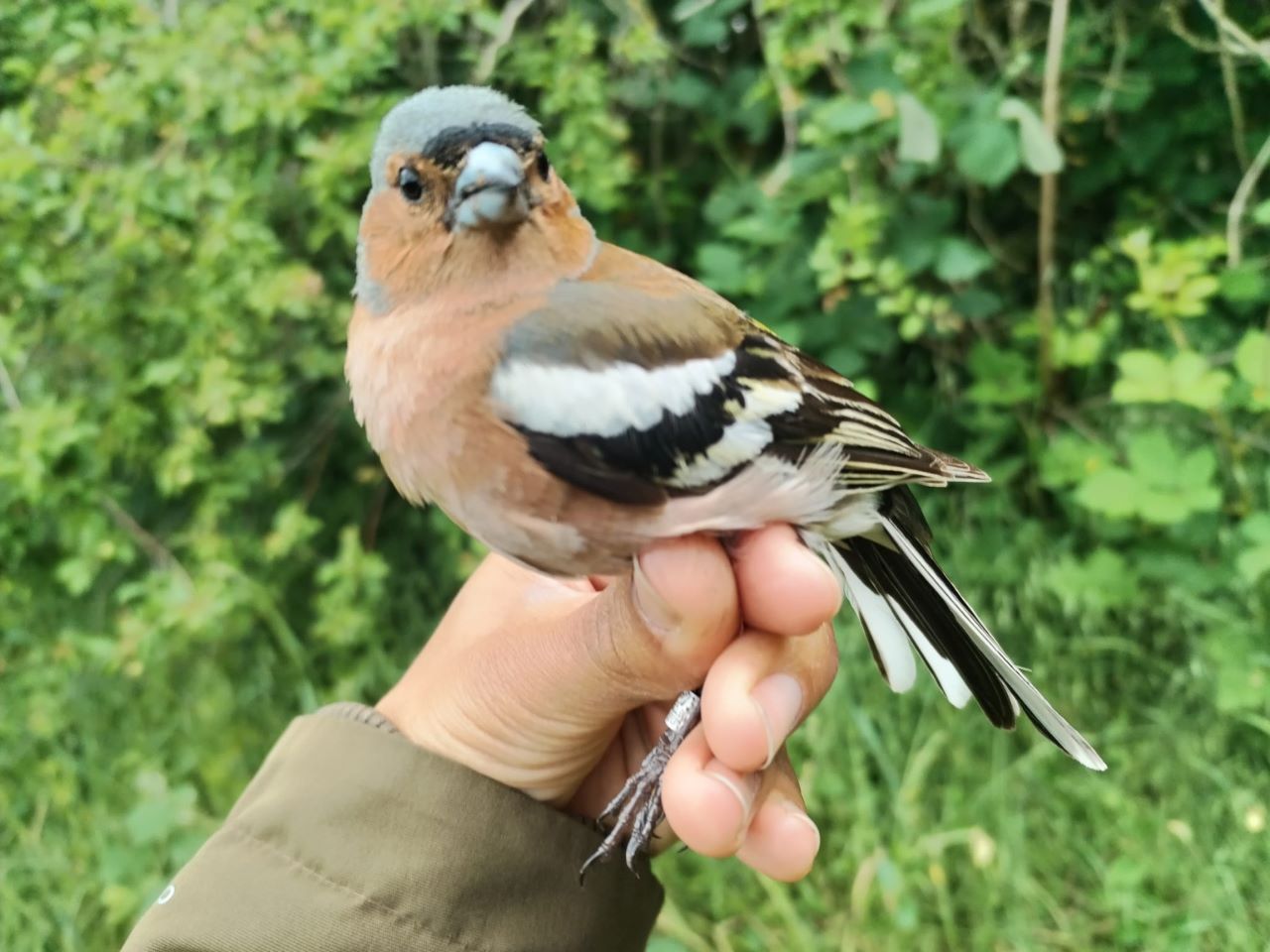
The stars of today, out two new birds: Chaffinch "Bogfinke"...
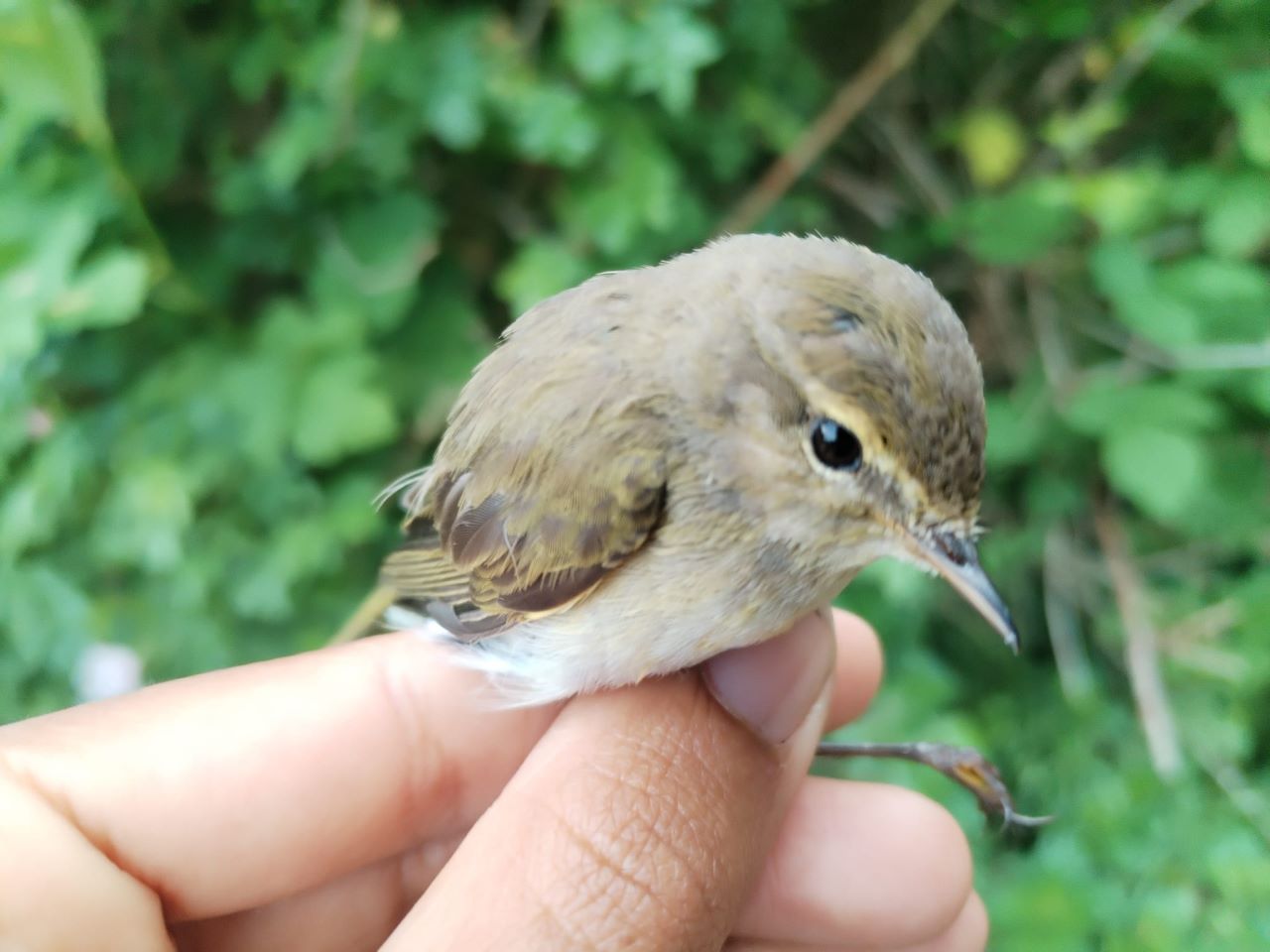
... and Chiffchaff "Gransanger"
After ringing, we went to Gerts place where some Blue Tit "Blåmejse" nestboxes are occupied and I got some more birds to ring, there were 11 Blue Tit "Blåmejse" chicks in two nestboxes.
The moths:
The windy night and light on just in one of the traps did not give many moths. I will go after finishing the blog to pug in the second trap again.
But it was some nice moth in the trap and unless yesterday, they were not so flighty, which made it way easier to take pictures. My favourite was definitely Macrothylaci rubi “Brombærspinder”. It carries this name, as one of the feeding plants of their caterpillars is the blackberry. This is a female, the male is more reddish and its antennae are bigger.

Macrothylacia rubi "Brombørspinder"
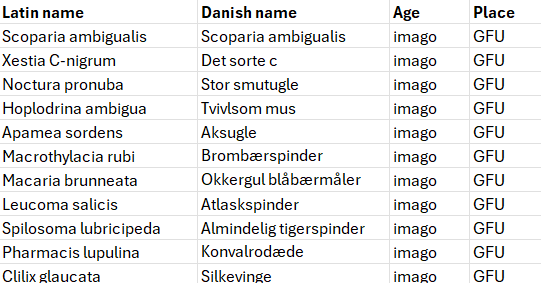
People: Jasper Mosman, Gert Jeppesen, Hans Lind, Hanelie Sidhu, Jens Friis-Walsted and Karsten
Taming the garden
The ringing:
The others were expecting it to be good today with birds in the nets, so I was really hoping for that. When I opened the nets, there was already bird song and activity in the garden. The first round was also okay with six birds, we had days where it brought just one or even zero birds. So I was hoping there would be some more birds in the following rounds, but there did not come more.

The “Overshooters” had breakfast at the tip, watching some birds and so the garden was mine and the birds and moth and hares. Soon I noticed, that it was and would stay everything else than wild in the nets with birds, but actually, it was with branches with young leaves which stretched themselves cheeky into the nets. But these I did not appreciate in the nets, so I decided to tame them a bit cutting the branches while I was doing the last zero rounds through the garden. Now the birds can come – hopefully. The most common species today was the Icterine Warbler “Gulbug”, with four new ringed and two recaptures. For the rest, see today´s list:
The moth:
Today I just had light on in one of the traps, but I was satisfied with the outcome. I had 15 different moth species in the trap, plus one photographed and identified at Bøtø. I will put pictures of two in the blog. The first one I want to show to you is Trichophaga tapetzella “Tapetmøl”. Gert was surprised that I caught it, it is quite rare to catch it. So a species to celebrate. If you find it in your wardrobe near some old fur coats, then I am not sure if it is. Because, in that case, it won´t be just a hazard. Because that species lives on dead skin with fur… Eventhoug, it is quite nice to look at.
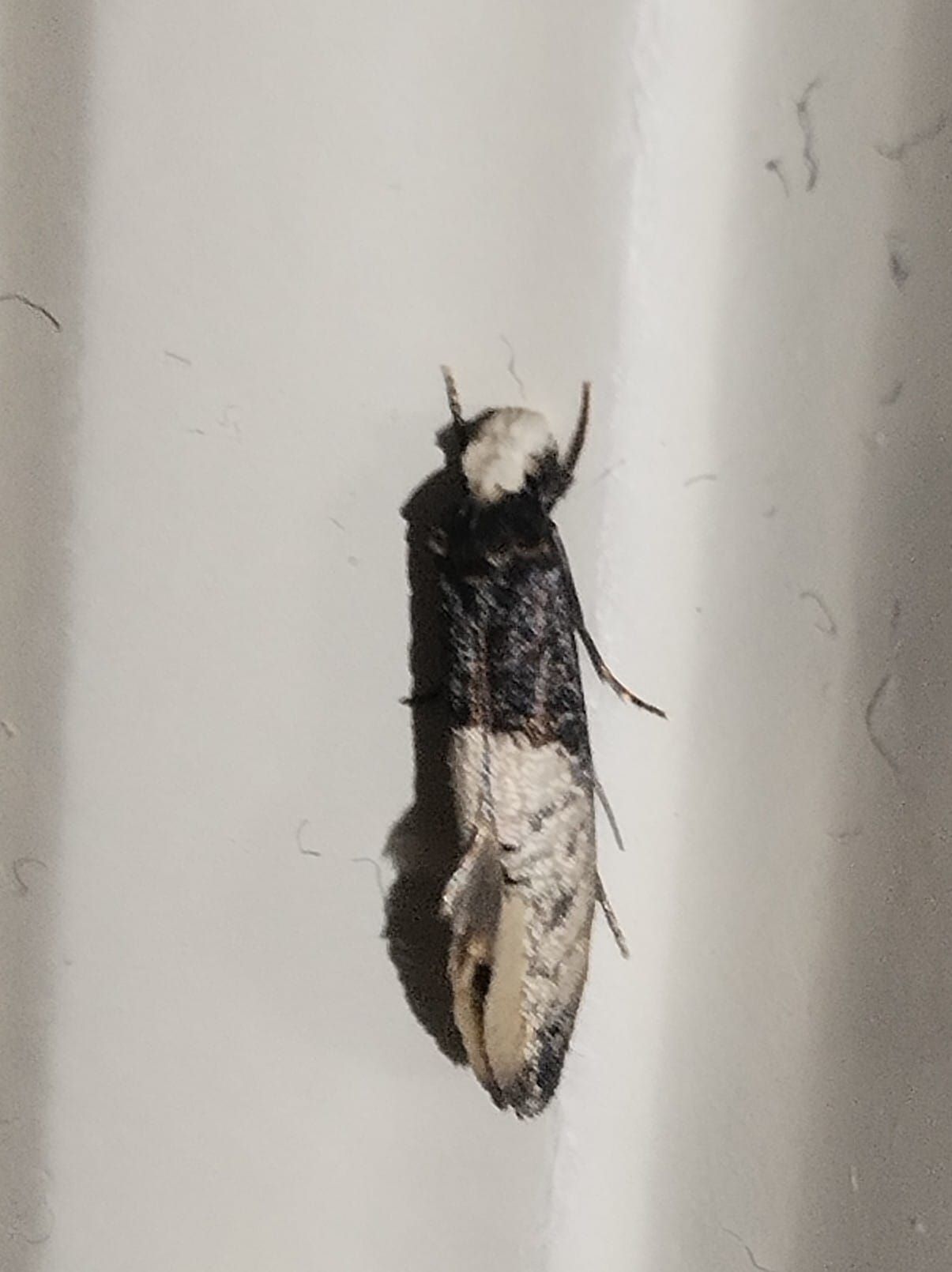
Trichophaga tapetzella “Tapetmøl”
Another species, that I thought was very nice and is for sure not pest is Mythimna pallens “Halmugle”, this species feeds on different grasses.
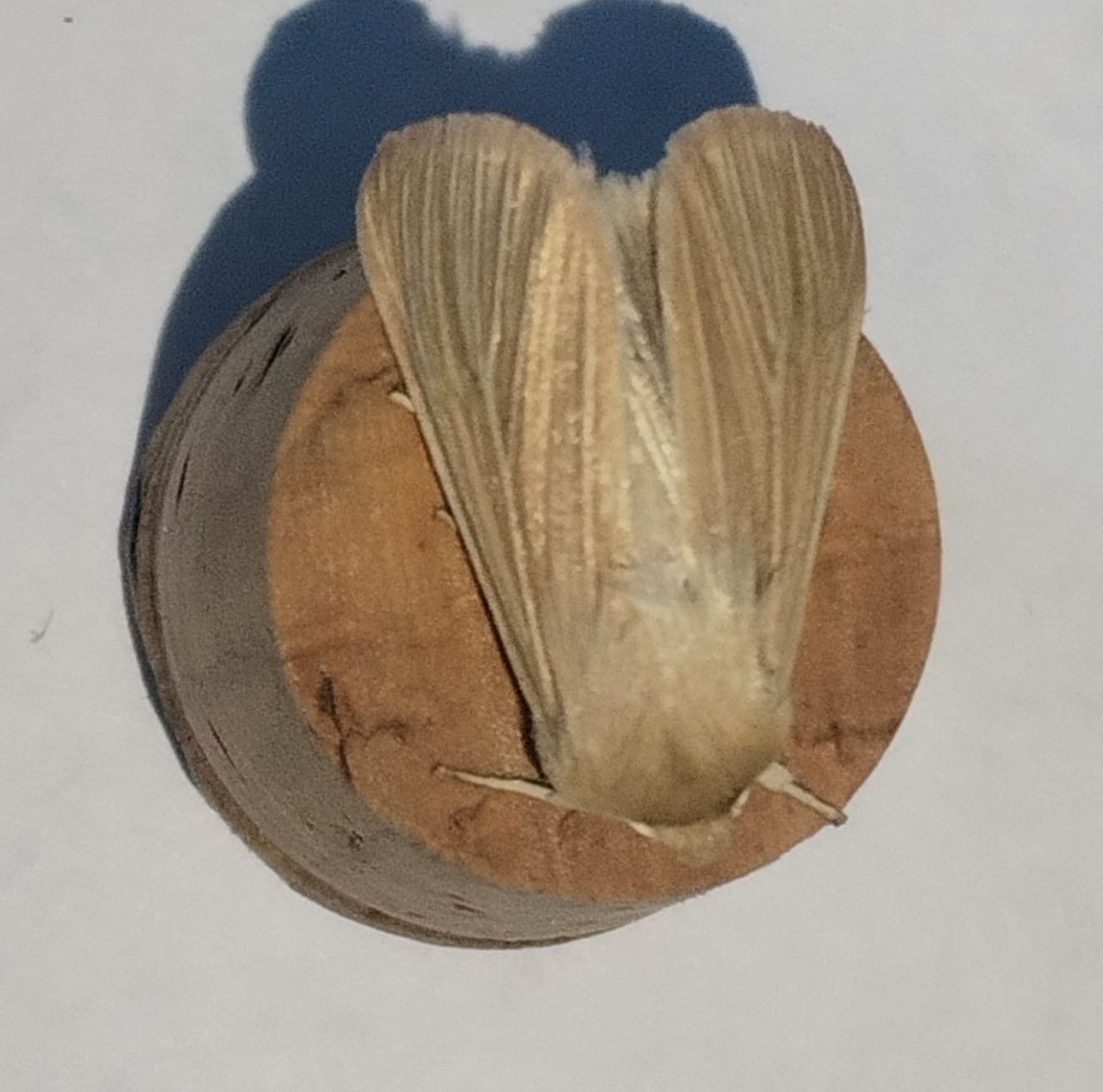
Mythimna pallens “Halmugle”
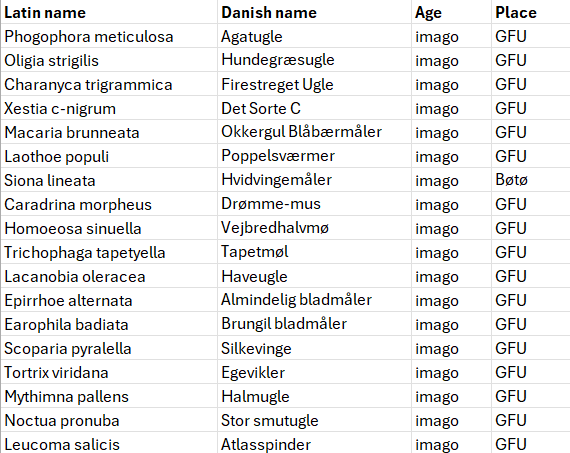
People: Tina and Mads Elley, Gert Jeppesen, Jens Friis-Walsted, Hanelie Sidhu and the "Overshooter"- birders
Karmindompap no. 9!
The ringing:
This morning was a little improvement to last morning, but just a little. Jens ringed the 9th Common Rosefinch “Karmindompap” of the season, it was in the net with one of the Common Rosefinches “Karmindompap” we had already some days ago.

Common Rosefinches "Karmindompap"
Also some of the birders who are here for the Overshooter Weekend came to them. As we catch so few of them this spring and we already noticed, that they are not doing so well this year, I will call a new Dunnock “Jernspurv” in the ringing the other highlight of the morning.

Dunnock "Jernspurv"
The moth:
Not many moths and not many species were in the traps this morning. They were also quite flighty already early in the morning, and also later, as it got quite warm today, so I am wondering, if there were some, that escaped before I saw them. A new one in the traps and for me today was Macaria brunneata “Okkergul Blåbærmåle” and it was also very numerous.
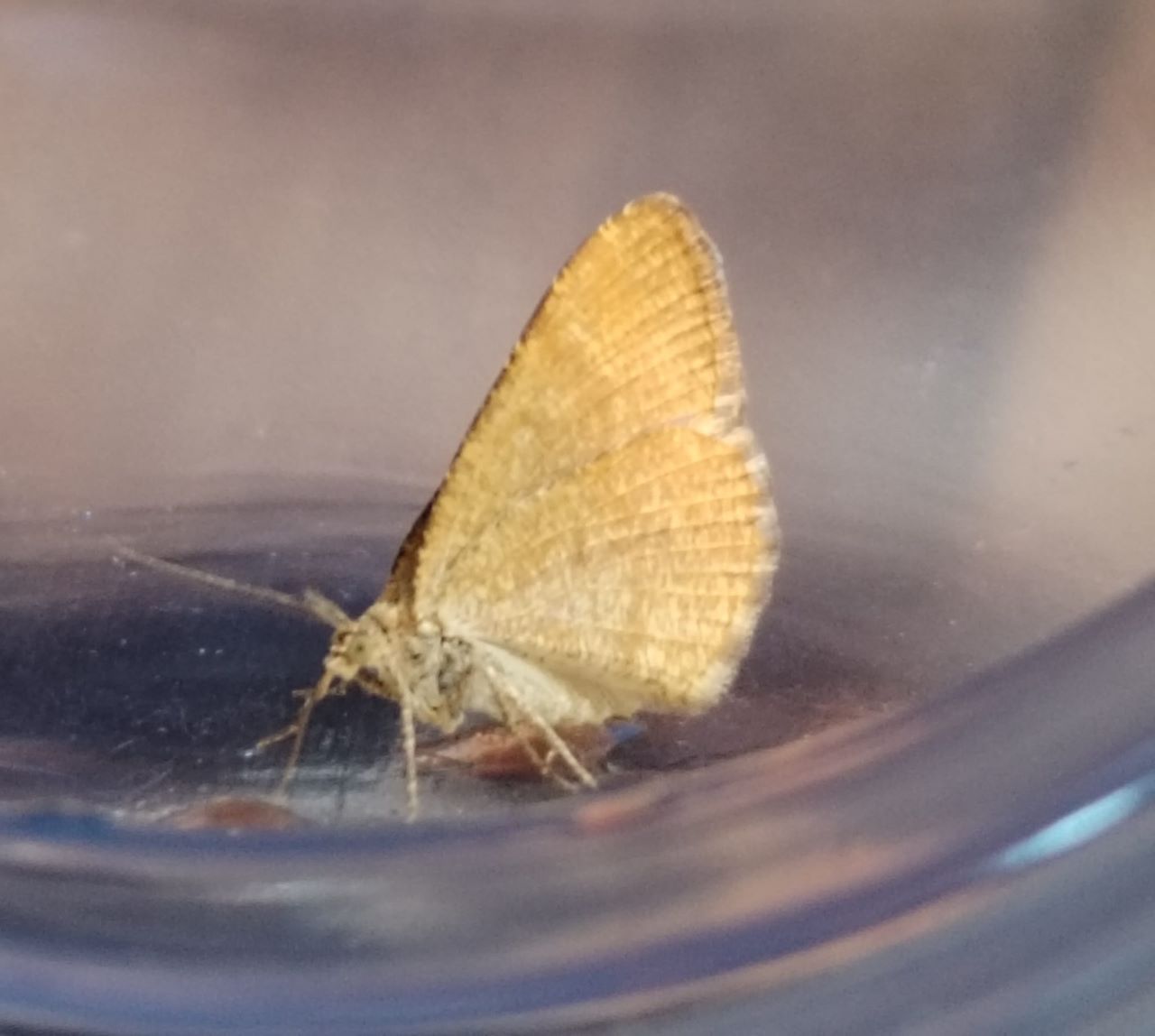
Macaria brunneata “Okkergul Blåbærmåle”
Phlogophora meticulosa “Agatugle” is a very common species but can be seen actually the whole year round, it will especially be very common in autumn, so I chose to show it, it is a good species to remember.

Phlogophora meticulosa “Agatugle”

Morning observation:
There were many people out today, that came for the Overshooting weekend. Highlights of the obs were a Serin “Gulirisk”, a Golden Oriol “Pirol” and some Honey Buzzards “Hvepsevåge”.
Observations of the they of observers in the area can be seen here
People: Tina and Mads Elley, Gert Jeppesen, Jens Friis-Walsted, Hanelie Sidhu, Overshooter-birders
Chick-watching at Bøtø
The ringing
Today it was mostly recaptures in the ringing and not many birds, just nine in total. The weather forecast looked a bit unstable but the rain of the night had stopped just before net opening time and during the five standard hours, there was just a very short shower that hid the ringing garden so I just walked the round while it rained and it stopped very soon, as I had already seen on the radar. I was not bored this morning though, as I had a very interested visitor who joined me on the rounds today. One the two friends of my mother, who are spending some holiday days at Denmark with her and visiting me, Christian from Munich, wanted to see the ringing. Luckily, there were some birds I could show to him and the rest of the time, I explained about the migration behaviour of long-distance and short distance migrants as well as of birds was the Blackbird “Solsort”, that we can actually see all year round, but they also do migrate shorter distances. The Blackbird, “Solsort”, that you fed in your garden in winter might be a bit further noth now in spring, Maybe just in northern Denmark or also in Sweden or Norway, while some Blackbirds “Solsort” that were wintering in Germany are here. There were also some moths in the traps that kept me busy.
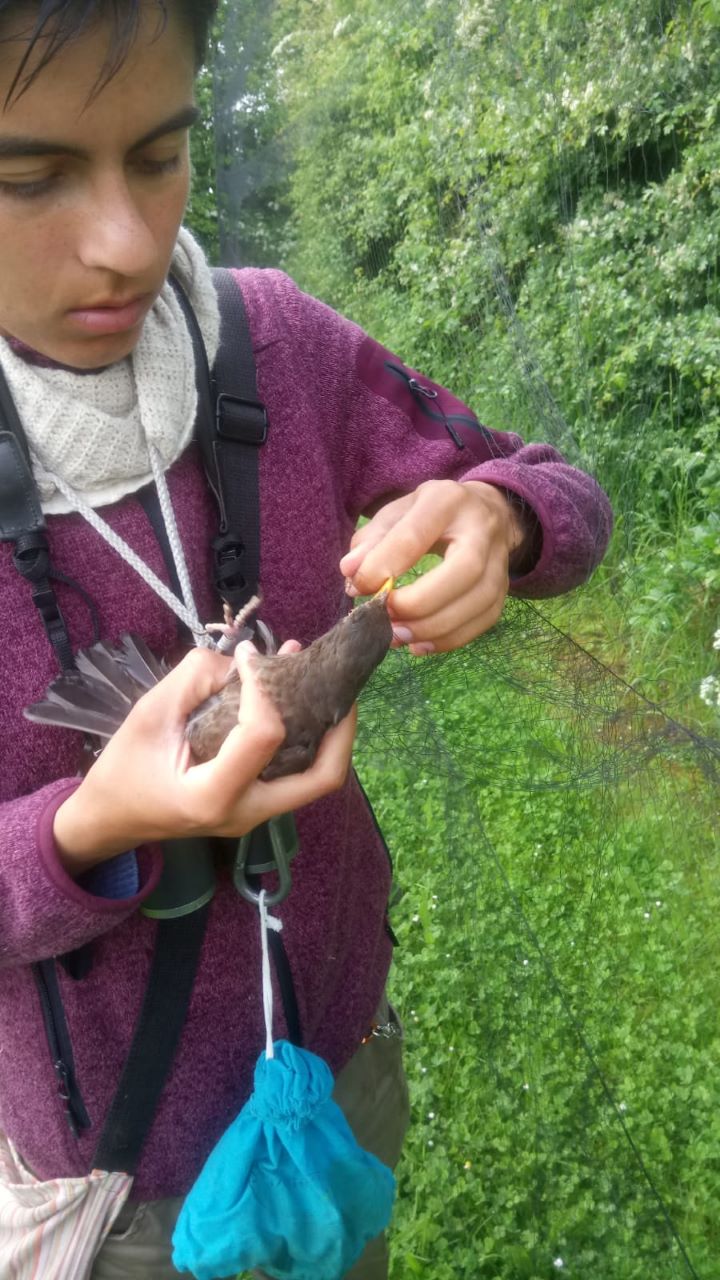

Tornirisk "Linnet"
The moths
There were 17 different moth species in the two light traps I am catching with now. Some of them I recognized but there were also some new. My favourite species of today was Noctua pronuba “Stor Smutugle”. The English name is Large Yellow Underwing. This is a quite good name as what I think is especially pretty on them is their orange (not yellow though, but there might be variation) underwing, that you see when releasing the moth by the time it flies away. It should be a very common species though, so there will probably be more the next days. Another new moth was Phragmataecia castaneae ”Rørborer”, which is called Reed Leopard in English, a quiet funny name. I think for a rainy night as toady this is an okay amount of moth species caught, and at Bøtø, I saw many moths flying and could identify two more species.
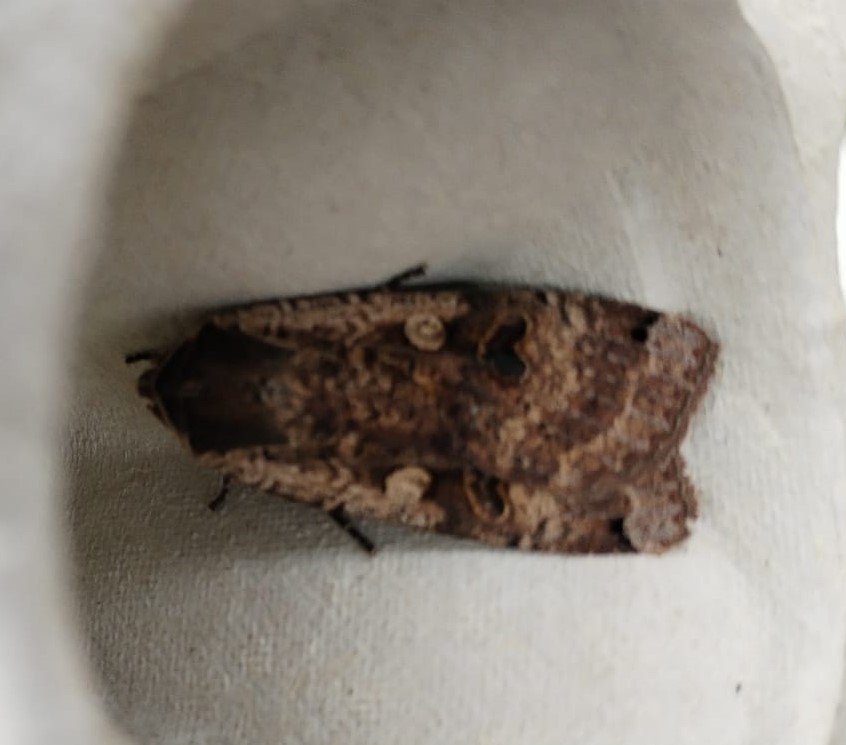
Noctua pronuba

Phragmataecia castaneae

Birds in the area
After all the morning work was done, Gert and I showed Bøtø to my mother and her friends. The topic of the trip was mainly chicks, we saw Crane “Trane” with their chicks, Avocets “Klyde” and their chicks and there are also young Oystercatchers “Strandskade” and White-tailed Eagles “Havørn” to admire.
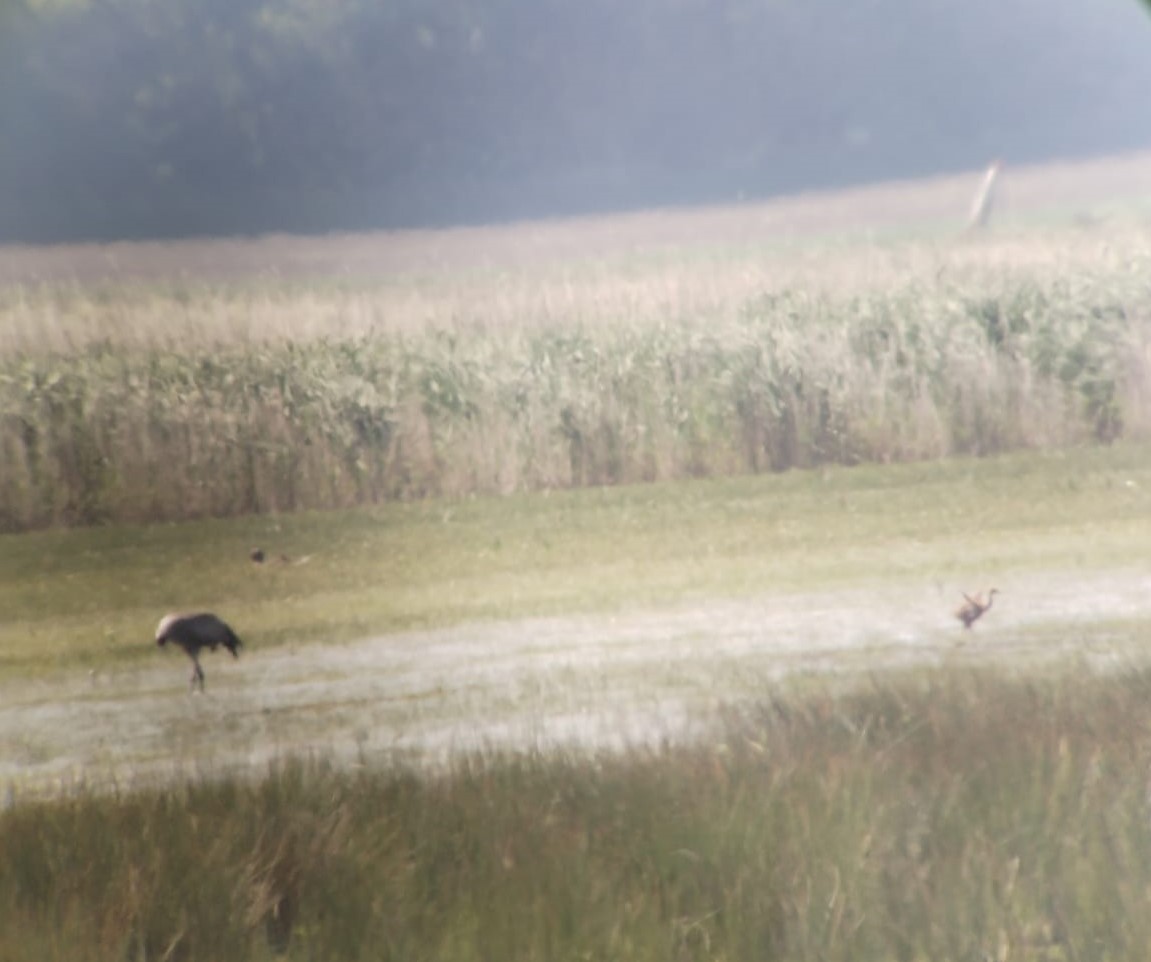
Crane "Trane" with chick
News of the station
Jens arrived this evening, he will be here for ringing for a bit more than a week. There is the Overshooter event this weekend, so we host a few birders over the weekend, who are hoping to see some good birds the nest days. Jasper also got family visit and they will explore Denmark a bit the next days, but he will be back on Monday.
People: Jens Friies-Walsted, Jasper Mosman, Gert Jeppesen, Mads and Tina Elley, Hanelie Sidhu and Karin
Grønirisk couples
The ringing:
Today there were quite a lot of recaps in the nets, but it was also some from last year or the year before. It is always nice to realize when entering data, that these birds returned to here for breeding. If it is breeding birds, we realize that on their brood patches, we often see on birds we catch at this time of year. Today we had both of the common Acrocephalus Warblers, Marsh Warbler "Kærsanger" and Reed Warbler "Rørsanger", but I think the highlights of today were two couples of Greenfinches "Grønirisk", both Robert and I found one couple of male and female together in the net.
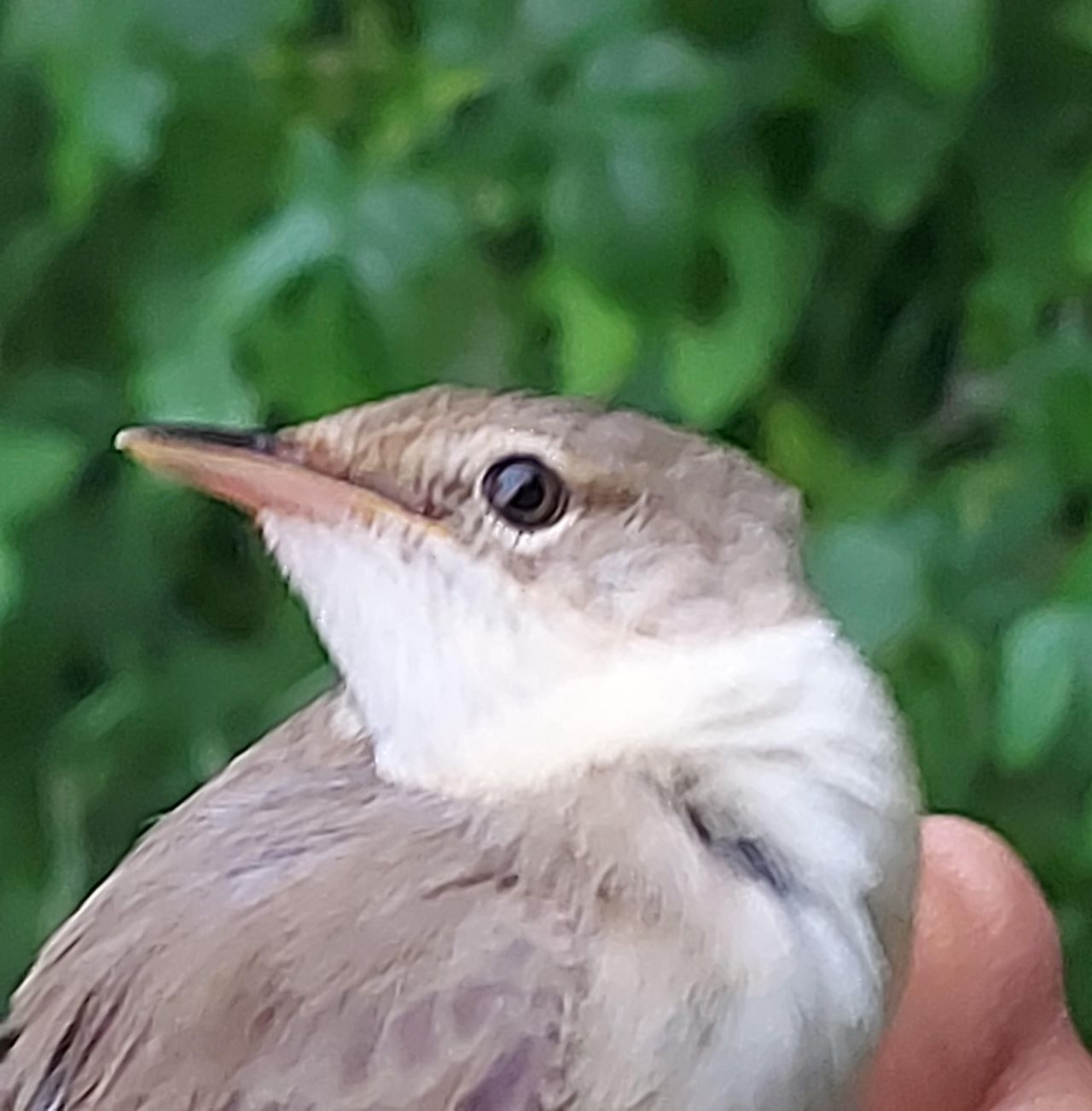
Marsh Warbler "Kærsanger"
The moth:
Last night and early morning were good for catching moths. In total 22 species and 6 new ones. That is what looking for moths makes it interesting, every day something new. I have chosen to show you the two following moths: the Straw Dot (Lille Å-Ugle) and the Common Yellow Conch (Tidselgulvikler).
This was my last day in Gedser for the spring, but will be back in September. Hanelie will probably go further with the moths, I have been able to get her interested in this intriging group of animals.
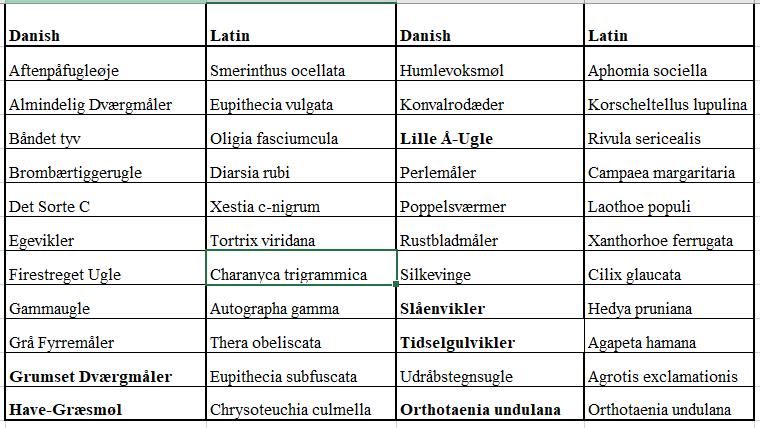
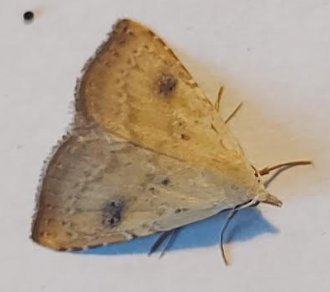
Straw Dot (Lille Å-ugle)

Common Yellow Conch (Tidselgulvikler)
People: Jasper Mosman, Robert Luttik, Hanelie Sidhu and our guest Karin
Again very few birds
About the birds is not much to mention today. Only 8 birds were flying in the nets (see table). At the point Hanelie saw a Corn bunting and a Bee-eater was flying over the garden.
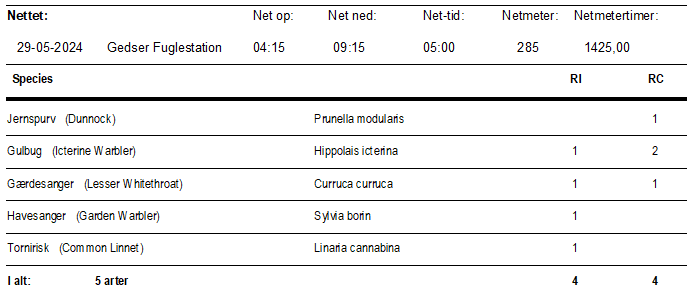
The moths were slightly less abundant, but still we had 17 species and 3 of them were new for the season at this location (bold in the table). Of two of the new ones a picture is presented below: it is the Båndet Tyv (Middle-Barred Minor) and the Benvedmåler (Scorched Carpet).
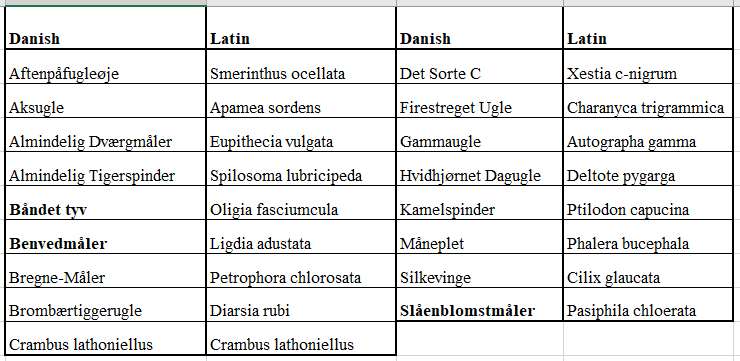

Båndet Tyv (Middle-Barred Minor)
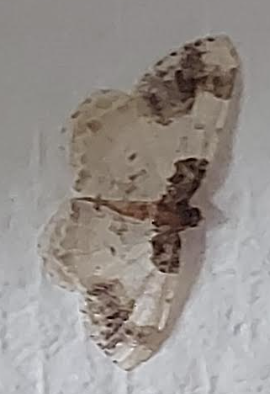
Benvedmåler (Scorched Carpet)
People: Jasper Mosman, Robert Luttik, Hanelie Sidhu and Karin
Is this the weather change we were hoping for?
- Ringmækening:
After checking the radar we found out that it was possible to open the nets before the rain came. First and second round were zero rounds though and the closing round brought one Icterine Warbler “Gulbug”. Later in the morning when the rain stopped, it was possible to open again, but it was not worth it, we did not get a second bird. Even though rainy days are not the most interesting, we are welcoming this weather change, it might bring some birds, when the bad weather front is over.

Todays one and only bird: A Icterine Warbler "Gulbug"
Catching moths was not influenced by the rain. We caught 21 species and again 5 new species for the season at this location. To catch every day new species is not so strange. In my garden I have caught more than 500 species in 3 years time. It is amazing how many species are flying around in the night. Because of the single bird we had today I will show a few more moths than usually. I have selected the following species: Elephant Hawkmoth (Dueurtsværmer), Maidens Blush (Ege-Bæltemåler), Green Oak Tortrix (Egevikler) and the Black-veined Moth (Hvidvingemåler).
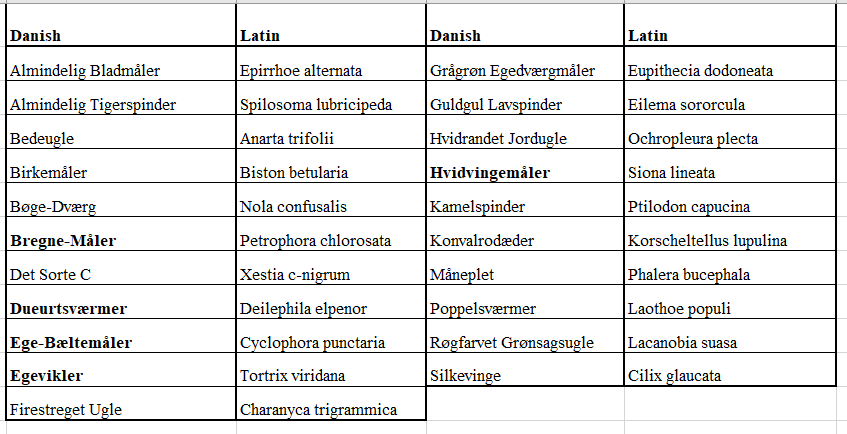

Elephant Hawkmoth (Dueurtsværmer)
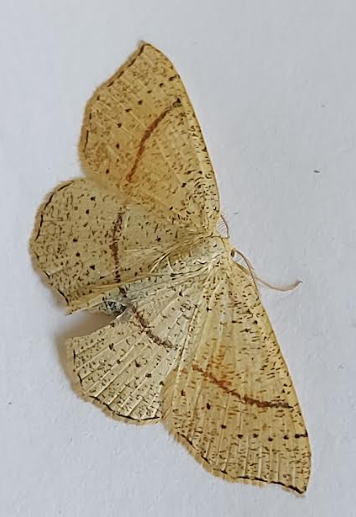
Maidens Blush (Ege-Bæltemåler)
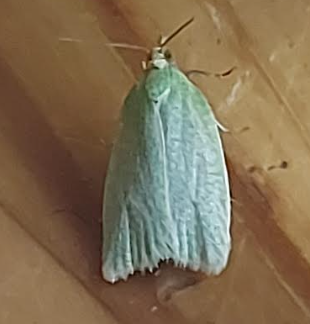
Green Oak Tortrix (Egevikler)
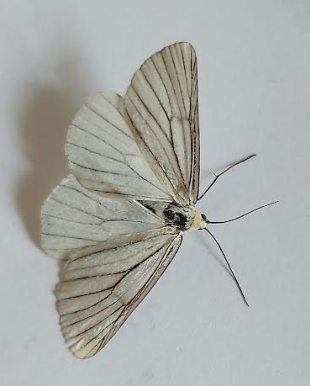
Black-veined Moth (Hvidvingemåler)
People: Jasper Mosman, Robert Luttik, Hanelie Sidhu and Karin
The overcasted sky brings some little surprises in the nets
Ringmærkening:
The weather forecast for this morning was a little unstable but and although we heard it thundering and saw amazing lightening scars on the sky, the rain just hit us very shortly so we could keep the nets open for the whole standard time. The sky was overcasted the during the whole morning and we opened the nets at the pond. They did not catch anything so far, but for today, it was a good decision. Two Skylarks “Sanglærke” went into one of the nets. We are hearing them every day all around, but they usually do not go into our nets. So they were a little highlight of the morning.

Skylark "Sanglærke"
Also the Sparrowhawk-nets were productive today. No, we did not catch Sparrowhawks but a Barn Swallow “Landsvale” and a Hawfinch “Kernebider” went in these nets today.

Barn Swallow "Landsvale"

Hawfinch "Kernebider"
Else, we caught the 8th Common Rosefinch “Karmindompap” for the season today. In total, we had 17 new birds of 11 species, but some little surprises in the nets so it was a quite nice morning.
The moth: Also the moths were doing well this night, there were quite some in the traps and on the walls. 25 Species and 5 new for the season (bold in the table). In contrast to the more brown or darker moths till now we had a few very colourful ones. One was light green, the Perlemåler, and one was yellow with a few darker patches, the Citronmåler.
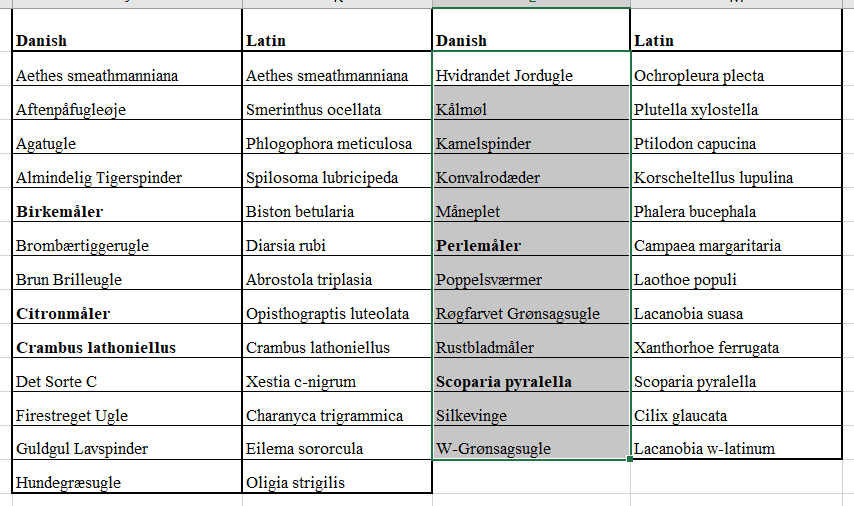
 Perlemåler (Light Emerald)
Perlemåler (Light Emerald)
 Citronmåler (Brimstone Moth)
Citronmåler (Brimstone Moth)
Nyt fra stationen: Ole left us this mornig but he will be back again for a short stay in two weeks.
In the afternoon, I got visitors from home, my mother arrived with two friends from Munich. She will stay here with us until the 1st of June.
People: Ole Friis Larsen, Jasper Mosman, Robert Luttik, Hanelie Sidhu and our guest Karin.
